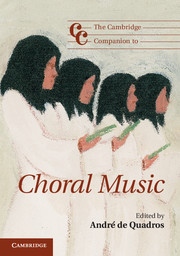Book contents
- Frontmatter
- 1 Introduction: choral music – a dynamic global genre
- Part I Choral music: history and context
- Part II Choral music the world over
- 6 Choral music and tradition in Europe and Israel
- 7 Canada's choral landscape
- 8 A multiplicity of voices: choral music in the United States
- 9 A hundred years of choral music in Latin America 1908–2008
- 10 Choral music in East Asia: China, Japan, and Korea
- 11 New voices in ancient lands: choral music in South and Southeast Asia
- 12 From chanting the Quran to singing oratorio: choral music in West and Central Asia
- 13 Voices of the Pacific: the (ch)oral traditions of Oceania
- 14 Choral music in Africa: history, content, and performance practice
- Part III Choral philosophy, practice, and pedagogy
- Notes
- Select bibliography
- Index
- Cambridge Companions to Music
13 - Voices of the Pacific: the (ch)oral traditions of Oceania
from Part II - Choral music the world over
Published online by Cambridge University Press: 28 September 2012
- Frontmatter
- 1 Introduction: choral music – a dynamic global genre
- Part I Choral music: history and context
- Part II Choral music the world over
- 6 Choral music and tradition in Europe and Israel
- 7 Canada's choral landscape
- 8 A multiplicity of voices: choral music in the United States
- 9 A hundred years of choral music in Latin America 1908–2008
- 10 Choral music in East Asia: China, Japan, and Korea
- 11 New voices in ancient lands: choral music in South and Southeast Asia
- 12 From chanting the Quran to singing oratorio: choral music in West and Central Asia
- 13 Voices of the Pacific: the (ch)oral traditions of Oceania
- 14 Choral music in Africa: history, content, and performance practice
- Part III Choral philosophy, practice, and pedagogy
- Notes
- Select bibliography
- Index
- Cambridge Companions to Music
Summary
In the beginning …
From the time that the ancient voices of Oceania were first heard, tens of thousands of years ago, there was singing. The songs belonged to the indigenous cultures that inhabited the many islands of the Pacific. They sang about their ancestors, their relationship with the land, their daily lives, and they told their Creation stories and communicated with their deities.
In the Pacific, singing represented an elevated form of verbal utterance. Singing, chanting, or intoning was deemed the most effective way to communicate with the deities, and the one sure way to appeal to the human appetites of the Polynesian pantheon was through good singing. Poets, composers, and choreographers (often one and the same person and highly regarded) wrote songs and choreographed dances, which added the visual dimension to the expression of the words. The singing traditions in Eastern Polynesia were unison, while those in the Western Polynesian tradition were choral, that is, they sang in parts. The songs were part of daily life and, more important, ritual, and the ability to sing was a part of the individual's self-identity. So great was the power of the uttered word expressed in both song and dance that the role given to instrumental music was comparatively small.
Songs were defined essentially by their function, and great expectation and importance were attached to the singing of them. Performances were socially significant, and ridicule and shame were attached to anyone who did not perform with style and excellence; for example, when a leader failed to start the group together. Group performances at festivals and special occasions created a degree of friendly rivalry and competition. Songs (in both recited and sung styles) were categorized according to their purpose, and chant formed the basis of much of their musical content. Like the Polynesian songs, the Aboriginal songs were defined by function. Inherited networks of song lines, the songs and verses that acted as maps and guides across the land, had to be preserved.
- Type
- Chapter
- Information
- The Cambridge Companion to Choral Music , pp. 177 - 184Publisher: Cambridge University PressPrint publication year: 2012
- 1
- Cited by



